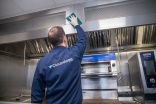Home › magazine › latest news › Hygiene in food preparation kitchen perils
Hygiene in food preparation - kitchen perils
22nd of July 2025Pests, cross-contamination, food tainting - ECJ looks at the food hygiene issues that need to be avoided in restaurants and considers how managers can avoid getting it wrong in the kitchen.
SCRUPULOUS CLEANING and rigorous hand hygiene are both crucial in any restaurant kitchen. But what is the worst-case scenario if strict cleaning and hygiene protocols are not met?
Contaminated surfaces, dangerously slippery floors and a breach of legal requirements is the response from Kärcher’s cleaning solutions consultant Gundula Braun. “This is not to mention the potential damage to a restaurant’s reputation when rodents or insects become attracted to an unhygienic kitchen area,” she said.
“A clean kitchen ensures food safety, maintains hygiene standards and prevents cross-contamination. And it shows cleanliness and hygiene are taken seriously, which earns the trust of guests.”
Thorough cleaning prevents the accumulation of bacteria, fungi and other pathogens that can lead to foodborne illnesses, Braun says. “It also eliminates food residues, grease and other substances that can harbour these microorganisms.”
Bacteria such as Salmonella, E.coli and Listeria can thrive in unclean environments, while cross-contamination could become an issue if harmful bacteria were allowed to spread from one food item to another, she adds. And unclean surfaces could accelerate food spoilage. “This is not only a waste of precious resources but will also increase the danger of foodborne illnesses and represent a risk to employees and guests.”
Any infringement of legal regulations could result in penalties from the authorities or even the closure of the restaurant, according to Braun. ”And if this infringement is witnessed by customers it is likely to be shared on social media resulting in a significant loss of reputation for the establishment,” she said.
Clear signage and checklists along with regular inspections can help to prevent such situations. “Staff should also be thoroughly trained on proper cleaning and personal hygiene procedures, while effective products and tools should be employed,” said Braun.
Kärcher offers a complete range of kitchen cleaning equipment including steam cleaners, scrubber dryers and high-pressure cleaners along with cleaning agents such as grease removers, disinfectants and surface cleaners.
Thorough cleaning safeguards the health and well-being of everyone who steps into the kitchen, according to Ecolab marketing and sales manager Michael Catling. And neglecting it could result in foodborne illnesses, ruined dishes and potential lawsuits.
“Consider the ripple effects of neglecting this crucial task,” said Catling. “Food poisoning could severely impact the health of customers and staff, while the contamination of dishes by meat products or allergens could result in dangerous allergic reactions.
Tarnish reputations
“But the repercussions don’t stop there. Poor cleaning practices can tarnish an establishment’s reputation, causing a loss of business and customer trust. And in extreme cases it could lead to legal action against the establishment which will put the business at risk.”
The entire team needs to recognise the impact that poor cleaning can have on the business and their jobs, Catling continued. “Emphasising the importance of following cleaning protocols and procedures can mitigate the risks and ensure a safe and reputable dining environment.”
All businesses need to foster a food safety culture and implement good training, clear signage and detailed cleaning plans, he adds. “It is also important to use high-performing products and systems designed to simplify and enhance the cleaning process for the team.”
Ecolab’s KitchenPro Program consists of kitchen disinfectants, degreasers, floor cleaners, oven cleaners and manual detergents. The company’s ReadyDose solution is a tablet-based system said to simplify cleaning routines.
Food preparation environments provide the nutrients and moisture required for microbial growth, according to Vikan’s global hygiene specialist Deb Smith.
“Thorough kitchen cleaning reduces the quantity of these nutrients and removes the general debris that may affect food quality,” she said. “And this minimises the risk of food allergen cross-contact.”
Inadequate kitchen sanitation can lead to severe consequences, according to Smith. “Pathogens such as Salmonella, E.coli, Listeria and Norovirus can survive on surfaces for days or weeks,” she said. “These can then be transferred to food and result in potentially serious illnesses.
“Even low levels of pathogen cross-contamination can cause life-threatening illness for immunocompromised individuals, pregnant women, young children and elderly consumers. And poor sanitation can also lead to microbial contamination impacting on food quality and shelf life.”
Smith says food allergies affect up to five per cent of adults and between six and eight per cent of children. “Even trace amounts of allergens can trigger severe or fatal reactions,” she said. “Similarly, meat contamination can be an issue for vegetarians, vegans and anyone with religious dietary restrictions. And allergens and meat residues could be unintentionally transferred to foods from utensils that have not been segregated or thoroughly cleaned between tasks.”
Food safety violations or outbreaks could lead to devastating reputational damage through social media, review platforms and news coverage, she said. “Health authority closures and poor hygiene ratings are publicly accessible and can permanently damage customer trust,” said Smith.
“Businesses could also face significant liability through customer lawsuits, regulatory fines, increased insurance premiums and even criminal proceedings in severe cases. The financial impact of such incidents frequently far exceeds what proper cleaning protocols would have cost to implement and maintain.”
Establishing a culture of hygiene requires a multi-faceted approach Smith believes. “Structured cleaning programmes should be put in place with clearly documented procedures, frequencies and responsibilities tailored to each area of the kitchen,” she said. “Staff should receive comprehensive training on how to clean and why each step matters. And the establishment should have appropriate staffing levels to ensure that cleaning tasks can be completed without unreasonable time pressure.”
Colour coding
Visual management tools such as colour-coded cleaning zone maps and illustrated cleaning guides can help. ”And digital monitoring systems will provide real-time tracking of cleaning task completion and effectiveness.” Vikan specialises in colour-coded cleaning and food handling tools. Besides brooms, brushes, mops and squeegees the company also offers colour-coded wall brackets, shadow boards and hooks and provides a digital Zone Planner to help customers implement a customised system.
Thorough kitchen cleaning prevents foodborne illnesses, cross-contamination, pest infestations and unpleasant odours, says Essity communications director Jenny Turner. “Low standards will be highlighted in hygiene inspections and feature in publicly-available ratings which will have a knock-on effect on the reputation of the business,” she said. “And in kitchens that are open to customers, any transgressions will have a direct impact on customer perception and trust.”
Insufficient cleaning could also lead to allergens or meat products contaminating other dishes and pose serious health risks to consumers. “It could result in a loss of reputation and bad customer reviews along with poor hygiene inspection ratings, customer dissatisfaction and potential lawsuits due to health violations and foodborne illnesses,” said Turner.
Ensuring thorough cleaning involves good training, clear signage, detailed cleaning plans and adequate staffing levels, she adds. “The use of high-quality cleaning products is also crucial, while the strategic placement of dispensers will ensure that products are always accessible which will minimise interruptions and prevent run-outs.”
The Tork Reflex Single-Sheet Centrefeed system is claimed to reduce paper consumption by up to 37 per cent compared with traditional dispensers. Also from Essity is the reusable Tork 2-in-1 Scouring Cloth described as being both abrasive and absorbent and capable of cleaning up tough messes without scratching surfaces.
Regular and thorough cleaning will prevent the spread of harmful bacteria and ensure all food prepared is safe to eat, says Cleanology marketing director Kate Lovell. “Insects or rodents could be attracted to food residues so it also helps to prevent infestations,” she said. “And a clean kitchen is more organised and efficient, allowing staff to carry out their tasks more easily.”
Poor cleaning standards could lead to a loss of reputation or lawsuits due to food poisoning or allergic reactions, she said. “The establishment may also receive fines or be forced to close due to health code violations, which may also cause reputational damage,” said Lovell.
Staff need to receive proper training and understand what products and methods to use, she said. “Adequate supervision will ensure standards are maintained and will allow cleaning staff to ask any questions if they are unsure,”added Lovell. “Clear signage may also be useful to avoid confusion relating to cleaning tasks. And it is important to have adequate numbers of cleaning staff to complete all tasks and to provide products of a high quality.”
Customer trust
Poor cleaning can irreparably damage a company’s image, agrees Filmop’s business development manager Paolo Scapinello. “It can lead to food poisoning complaints plus negative reviews resulting in a loss of customers and a consequent drop in revenue,” he said. “Customer trust is essential for a business and can only be maintained by ensuring high standards of hygiene.”
A good cleaning regime requires the utmost care coupled with the right equipment. “The combination of these two factors along with proper training will help to maximise hygiene and minimise the risk of cross-contamination,” added Scapinello.
Food allergens can cause severe reactions if they are not properly removed from surfaces, utensils or equipment, he says. “It is essential to prevent this from happening through rigorous and systematic cleaning procedures to ensure food safety and health protection,” he said.
Filmop’s Globo touch-free mopping system is claimed to reduce the risk of cross-contamination and may be combined with the Twice wringer bucket. Both products are described as having a user-friendly design to minimise the risk of error.
So what are companies’ top tips to avoid getting it wrong in the kitchen?
All dispensers should be placed in strategic locations to minimise interruptions to workflow, says Essity’s Jenny Turner. “Using the right products and systems will help to ensure cleaning is carried out thoroughly and efficiently, reducing the risk of contamination.”
Site-specific training and regular quality audits are crucial, says Cleanology’s Kate Lovell. “We also operate a zonal system whereby each cleaner has responsibility for certain areas of the building to engender pride in their work.”
And easy-to-understand cleaning processes coupled with proper staff training will ensure that no task is missed, even under pressure according to Kärcher’s Gundula Braun. “However, the key ingredient is staff motivation and this can be achieved with the aid of clear guidelines, proper instruction and ergonomic tools and equipment,” she said.











